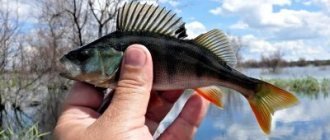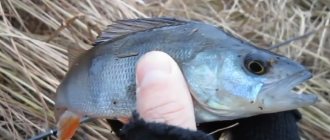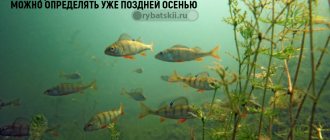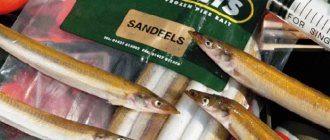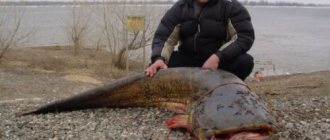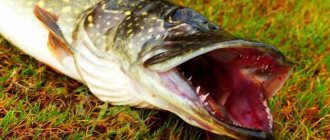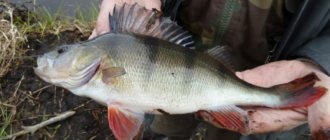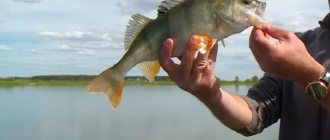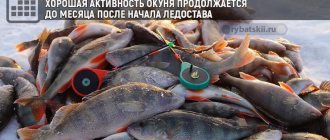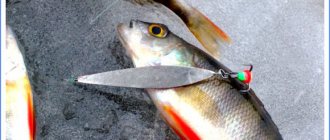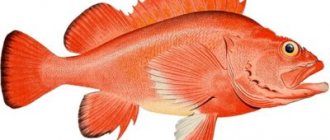As a rule, the basis of the diet of this striped predator are small individuals, 6-8 cm long. Despite this, perch can bite on worms, especially in spring, on small crustaceans in summer and gammarus in autumn. If the perch cannot find suitable food for itself, it can switch to feeding on insects. Perch is characterized by the fact that it will always pursue the type of food that is easy to obtain.
For its hunting, it chooses clean areas of the reservoir, hiding in thickets of aquatic vegetation.
Fishing with live bait involves catching larger individuals of perch using small fish. Smaller specimens are successfully caught using a worm.
The advantages of this type of fishing include the fact that it is not difficult to get suitable live bait, as well as the likelihood of catching a large striped predator, compared to using a worm or maggot. Disadvantages include problems with hooking small fish and problems with storing them. Experienced fishermen solve this problem without any problems. If fishing is carried out in the summer or in conditions when the reservoir is not yet covered with ice, then live bait can be caught directly on the river or lake. In this case, one part of the problem disappears.
The following types of fish are considered the best small specimens used as live bait: crucian carp, minnow, verkhovka, roach, bleak, gudgeon, chub, including small perch.
How to catch live bait
Catching small specimens is not difficult. There are reservoirs where you can catch fry by moving half a meter from the shore (into the water) and scooping up water with a regular jar. This simple method allows you to catch from 1 to 3 fry at a time. But this is purely theoretical. In fact, you won’t catch a fish this way, even a small one.
Unfortunately, not every body of water can find such a density of fish, so fishermen use a “baby fisher”. Before installing it, it is better to feed the place to guarantee a catch. The presence of at least some food source will be able to collect a sufficient number of small fish in one place. This device is installed closer to the bottom. After a certain time, the tackle is removed from the water, after which most of the “trifles” that floated above it end up in the net of the device.
The simplest option is to buy live bait at the market or in a specialized store. Although this simple option is fraught with a certain danger associated with the activity of live bait. It may happen that upon arrival at the reservoir there will be nothing left to put on the hook.
Method of catching live bait
Storage and transportation of live bait
Everyone knows that caught “little things” do not live long, so it is important not to catch live bait, but to preserve it. Live bait is stored under the following conditions:
- Constant temperature . Neither cooling nor heating of water is allowed.
- Frequent water changes to provide the fish with oxygen.
To store the fry, select containers of appropriate sizes. It is very important that there is enough free space and oxygen for the fry. A ten liter bucket of water is ideal. At the same time, the water in the bucket should be changed regularly. If you notice that the fry are staying near the surface of the water and trying to swallow air, then you need to urgently change the water.
The fry are transported in a closed container with water. There should be a lot of water, since the container closes tightly, and there is practically no access to oxygen.
There is another option, which is aimed at not killing fish fry. It comes down to the use of artificial baits that imitate the movements of live fish. If you practice a little, it’s quite possible to give up live bait.
Gear selection
Rod
The choice of gear should begin with the choice of a fishing rod. When choosing, you should take into account the fact that the lips of the perch are soft and the tip of the rod should also be soft. The soft tip will not allow his lip to be torn off, which happens quite often among inexperienced fishermen.
fishing line
The selected fishing line can have a thickness from 0.22 to 0.25mm. The color doesn’t really matter, but it’s better to take a neutral or green fishing line. Both colors can go unnoticed by bass: the neutral color will really blend in with the water, while the green color will match the color of the vegetation. Naturally, you should give preference to high-quality fishing line, which is not cheap. An alternative option is fluorocarbon, which is increasingly being used by anglers. The fish certainly won’t notice it. Although fluorocarbon has specific characteristics that cannot affect perch fishing.
Hooks
Particular attention should be paid to the choice of hook. In our time, the most catchy hooks are those that have a medium-length shank and a sting curved inward.
We must not forget that fry must remain active under water for a long time. Therefore, it is better to opt for hooks made of thin wire, so as not to injure the live bait.
Coil
The coil is only inertia-free. This type of reel is very popular these days because of its simplicity and reliability, especially if the reel is from a well-known manufacturer. On the other hand, perch does not grow to serious sizes and there are no special requirements for the reel.
Float
The float can be anything. Although it is important to take into account the nature of the predator’s bites: the float can move to the side or go under water.
Time and place for catching perch on a donk
Perch tend to lead a school life, so when you get a bite in one area, it makes sense to re-cast the gear. Usually there are 10-15 individuals in one flock. The striped predator mainly goes for bait; the right mixture will ensure successful fishing, but it does not have any special preferences when it comes to places.
It is easiest to find fish during the summer fishing season, as they reveal their location by splashes on the water that appear during the hunt. It is easy to identify a promising area by the formation of a cauldron of fry - in the center there is a predator. The predator tends to make characteristic sounds that are not characteristic of any other underwater inhabitant. In summer, the fish stay in shallow water, close to vegetation or riffles, as there is a lot of prey here.
When planning the time period and place for fishing, you should consider:
How to attach live bait
Before attaching live bait, you need to select the appropriate hook size. The size of the bait fish and the size of the hook should be comparable. If you use a large hook, the baitfish will not live long, and if it is small, the baitfish may come off the hook. Live bait is baited in several ways:
- The hook catches on the tail. Moreover, the tail is wrapped in advance with nylon or nylon thread.
- The hook clings to the back in the area of the upper fin. In this case, care should be taken not to injure the small fish, otherwise it will simply die.
- Attaching the hook in the head area , when the hook is threaded through the mouth and out through the gills. This is considered the simplest and most reliable method.
In still water, it is possible to catch perch using a jig with baited fry. A jig quite often helps out a fisherman in conditions where fishing with a float leads to constant snags. When fishing in spring and autumn, it is advisable to use a fishing line of 0.17-0.22 mm. In winter, it is recommended to use even thinner fishing line - 0.13-0.14mm. This is due to the fact that in winter the fish are not so active and can be alerted by rough tackle.
Fishing with a jig is ordinary, using classic types of fishing.
When placing live bait on a hook, you should remember that the fry is able to get the tackle behind any obstacle. Therefore, you need to choose suitable places to avoid snags.
Perch rig
For fishing to be successful, you need to be well prepared. Therefore, it is necessary to prepare various devices for this:
1. Take the rod and reel. What is needed is a long rod, and the reel should not be inertial. 2. Prepare fishing line and a special float. The float must be sliding, because it is this that affects the casting distance and accuracy. If there is wind, and you have a very ordinary float, it can easily be blown away. In this case, the sinker will be in the other direction. 3. We take limiters that will be of different sizes (rubber or silicone). They are used to fix the float at the desired depth. The sinker must rest on the stopper so that the line knot does not break. 4. You need to take a metal leash so that pike teeth cannot damage the tackle. It will also prevent the fry from twisting the fishing line into the spring. 5. To make it more reliable, you can take good hooks for catching perch; bites when idle will not be so frequent.
A good fisherman has special tricks for such cases. We attach the live bait behind the back on one hook, and then on the lip on the second hook. You can leave the second hook without anything, so that there is a safety net against idle bites. When the bait is sluggish, you can move the rod to attract the perch to the fry.
Perch is a very smart fish. If he sees the bait, he immediately pounces on it and swallows the fish very reliably. This means that it is better to use a number 8 hook for catching. If you use just such gear, then catching a large perch will become much easier.
When hunting for predatory fish, you need to use bright and heavy floats. The sinker should be positioned 2-10 cm from the float. A 4-6 m rod would be ideal. You need to choose something convenient that is easy to catch perch in shallow water. The thickness of the fishing line must be at least 0.2 mm.
Read: Carp on the feeder in winter
Features of fishing by time of year and day
At different times of the season, perch can be found on different water horizons. Small and medium-sized individuals prefer to be in creeks with dense aquatic vegetation. With the arrival of autumn, they all move to open areas of the reservoir. As for large perch, they spend most of their time at depth and rise from there only in the mornings and late evenings.
Perch is a schooling fish. Each flock can number from 10 to 15 individuals. So, having caught one striped predator, you can count on subsequent bites.
In reservoirs with stagnant water, perch prefers to be in the vicinity of deep-growing plants, near unpolluted places. In rivers, perch also inhabits thickets, and in their absence, places with weak currents, where there are underwater piles of stones, boulders and snags. Perch begins to be caught at dawn and finishes biting at sunset. Compared to other types of fish, perch is not caught at night. It is most active on a warm sunny day early in the morning and at sunset. During these periods, large perch come out to hunt after spending the whole day in shelter at depth.
Fishing in warm weather
In spring, summer and autumn, perch is caught as usual, but with the arrival of winter, a lot changes. Perch is most actively caught 1.5-3 weeks after freeze-up. Moreover, they catch perch in the winter in the same areas of the water area as in the summer. In the midst of winter, perch breaks up into small schools of 5-7 individuals and migrates throughout the reservoir, in search of deeper places. Cold water forces perch to leave their usual places.
Fishing in winter
A good bite of perch in winter is observed in calm, windless weather with frost from 10 to 20 degrees. As a rule, perch activity is observed in the morning and evening hours.
Fishing techniques and tactics
The technique and tactics of catching perch with live bait are no different from this type of fishing for other predators. To be brief, the main task of the fisherman is to properly manufacture the gear, select a promising area for fishing and timely hook the predator.
Only fishing on a river with a current has some differences from fishing on lakes and ponds. True, they are insignificant and differ only in the right choice of place for fishing.
On the current
Backwaters overgrown with grass, whirlpools and areas with reverse currents are considered the most promising places for finding perch in reservoirs with a current.
If there is a steep bank on a reservoir, then the fisherman has an excellent opportunity to move along it. In this case, you need to throw the equipment under bushes and snags. In such places there is a very high probability of finding large perch.
In still water
In large water areas, it is best to identify promising fishing spots in advance. Very often you can do this by looking at seagulls. Seagulls hover over the water in places where the fry accumulate, and perch also graze them under the water. Along the shore you can often see schools of small fish jumping out of the water; perch is definitely hunting there.
But if you do not notice a flock of seagulls or splashes from fry, then this is not at all a signal that there is no fish. For example, in the cold season, the fry goes deeper, and the predator goes with it. So you should always pay attention to the topography of the reservoir.
